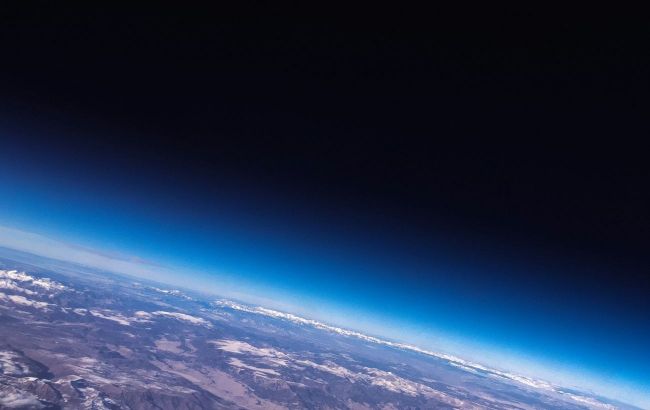Horizontal rains and no hurricanes. What would it be like if Earth were flat
 What would it be like if Earth were flat (photo: Unsplash)
What would it be like if Earth were flat (photo: Unsplash)
The evidence that the Earth is spherical is overwhelming. Nevertheless, there are still a significant number of people who believe that the Earth is actually flat, and scientists are deliberately hiding this fact. RBC-Ukraine tells what the consequences would be if the Earth were flat.
The following sources were used to write the material: Space.com, State of the Planet, Live Science.
The disk would have collapsed back into the planet
Before we consider the possibility of making the Earth flat, let's understand why it has the shape of a circle - it's due to gravity. Gravity is a force that acts between all objects with mass in the universe and attracts them to each other.
Because of gravity, matter tends to take on the most compact form when each particle is uniformly close to the center, forming a sphere. Even in zero gravity on the ISS, water does not form droplets, but turns into a sphere.
Already in 1857, physicist James Maxwell refuted the possibility of flat objects in space by studying the rings of Saturn. Previously, many astronomers considered them solid and hard, but Maxwell's calculations showed that they could be neither solid (otherwise they would be destroyed by gravity) nor liquid (in which case they would disintegrate into drops). The physicist found that they consist of a swarm of small, unconnected meteorites.
If the Earth suddenly became flat, it would cause serious problems. Gravity would begin to shift matter toward a common center, and the Earth's disk would quickly fall apart and then collapse back into a sphere.
Such a geologic catastrophe on a flat planet would be catastrophic, grinding up a million tons of soil and completely destroying life.
Trees would grow at an angle
Let's consider a hypothetical situation: suppose the Earth becomes flat, but at the same time stable due to the use of a super-strong material such as Adamantium or Vibranium. How would life on such a planet change?
Geophysicist James Davis of the Lamont-Doherty Observatory at Columbia University points out that gravity on a flat Earth would behave in an unusual way. Proponents of the flat earth theory assume that gravity will always be directed downward. However, in fact, it will pull toward the center of the disk, which will lead to a number of interesting consequences.
It is important to note that the presence of gravitational force affects plant growth through a phenomenon known as geotropism. This is the directed growth of organisms caused by gravitational force.
Plants, fungi, and some other organisms tend to grow vertically upward, which allows them to receive the maximum amount of light, water, and nutrients. If plant cells could not use gravity to define up and down, they would grow roots into the sky and die from lack of soil around them.
On a flat Earth, plants would start growing vertically only in the very center of the disk, which corresponds to the North Pole on the map of flat Earth proponents. In other parts of the disk, the trees would deviate away from the center, and near the edges they would spread out on the ground.
Things would fall sideways instead of down
On a flat, disk-shaped Earth, physical laws would face unusual challenges. Because of the gravitational vector directed toward the center of the disk, objects would fall vertically only near the pole. Elsewhere, all falling objects would move at an angle. At the edge of a flat Earth, objects would not fall down, but would roll toward the center.
Traveling on Earth would be difficult because of the constant feeling of rising as you move away from the center of the disk.
Those who bravely ventured to the edge of the Earth would need climbing equipment, because in the last stages they would have to overcome horizontal sections by crawling and anchoring themselves to the planet's surface with ice axes. Horizontal movement would resemble climbing steep cliffs.
The atmosphere would accumulate in the center of the disk
Today, the Earth's atmosphere is approximately the same thickness around the entire globe because gravity acts equally everywhere.
However, on a flat Earth, the climate would be much different. The entire atmosphere would begin to concentrate in the center of the disk. As a result, a region of air with high density and pressure would form in the middle of the plane, and a space vacuum would appear at the edges.
Life could exist only in the temperate regions of a flat Earth. In the center of the disk, conditions for life would be extremely unfavorable due to extreme levels of air pressure and temperature, and near the edges we would face unbearable conditions.
Vertebrates, including humans, would have died in seconds, and less resilient life forms, such as plants, would have survived for several hours before disappearing. In addition, due to the lack of atmospheric pressure, the water at the edges of the disk would evaporate quickly, and these areas would turn into deserts.
Rains would start falling horizontally
If gravity were directed to the center of the planetary disk, precipitation would also condense to this point. Thus, only in its middle would the weather be similar to what we are used to on a round Earth. The further away from the center of the disk, the more horizontal the precipitation would become.
James Davis of the Lamont-Doherty Observatory notes that as a result, all the water on a flat Earth would be concentrated in the center of the world, forming a huge ocean there. The further away from the center, the drier the climate would become.
There would be no more earthquakes and hurricanes
However, a flat Earth would have its advantages. For example, there would be no geological activity, such as the movement of tectonic plates. This means that there would be no more volcanic eruptions and earthquakes.
In addition, hurricanes and typhoons would not occur on such an Earth. This is because the destructive force is also related to the Coriolis effect: vortex funnels are formed due to the influence of inertia on wind flows caused by the daily rotation of the planet.
It is because of the Coriolis effect that hurricanes always rotate counterclockwise in the Northern Hemisphere and clockwise in the Southern Hemisphere.
There would be no aurorae and no Earth's magnetic field
The lack of geological activity leads to some problems. According to NASA, on a normal spherical Earth, the rotation of molten metal surrounding the iron core inside the planet generates powerful electric currents. They form a magnetic field that protects the planet from solar radiation.
On a flat Earth, however, a solid round core could not form due to the specifics of gravity on such a planet. The liquid rocks inside would be distributed closer to the center of the disk and would not rotate by inertia around the core. Consequently, there would be no magnetic field on such a planet.
This means that life on a flat Earth would be impossible due to the influence of solar radiation. Auroras would also be impossible on such a planet.
Over the next millions of years, the solar wind would gradually blow away the atmosphere of a flat Earth, and then the water would evaporate. As a result, the conditions on such a planet would be similar to those on Mars.

